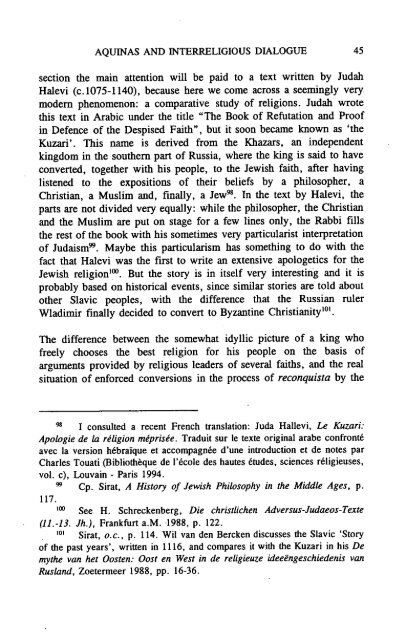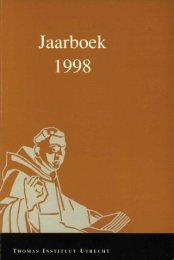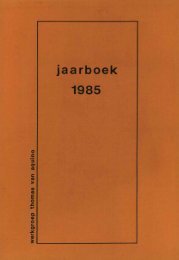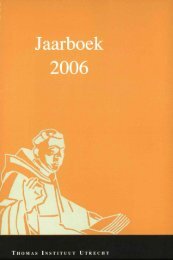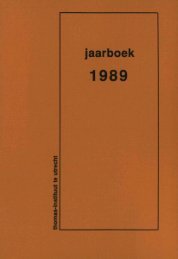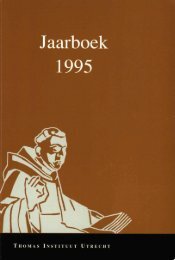Jaarboek Thomas Instituut 1997 - Thomas Instituut te Utrecht
Jaarboek Thomas Instituut 1997 - Thomas Instituut te Utrecht
Jaarboek Thomas Instituut 1997 - Thomas Instituut te Utrecht
You also want an ePaper? Increase the reach of your titles
YUMPU automatically turns print PDFs into web optimized ePapers that Google loves.
AQUINAS AND INTERRELIGIOUS DIALOGUE 45<br />
section the main at<strong>te</strong>ntion will be paid to a <strong>te</strong>xt writ<strong>te</strong>n by Judah<br />
Halevi (c.1075-1140), because here we come across a seemingly very<br />
modern phenomenon: a comparative study of religions. Judah wro<strong>te</strong><br />
this <strong>te</strong>xt in Arabic under the title "The Book of Refutation and Proof<br />
in Defence of the Despised Faith", but it soon became known as 'the<br />
Kuzari'. This name is derived from the Khazars, an independent<br />
kingdom in the southern part of Russia, where the king is said to have<br />
conver<strong>te</strong>d, together with his people, to the Jewish faith, af<strong>te</strong>r having<br />
lis<strong>te</strong>ned to the expositions of their beliefs by a philosopher, a<br />
Christian, a Muslim and, finally, a Jew98• In the <strong>te</strong>xt by Halevi, the<br />
parts are not divided very equally: while the philosopher, the Christian<br />
and the Muslim are put on stage for a few lines only, the Rabbi fills<br />
the rest of the book with his sometimes very particularist in<strong>te</strong>rpretation<br />
of Judaism?'. Maybe this particularism has something to do with the<br />
fact that Halevi was the first to wri<strong>te</strong> an ex<strong>te</strong>nsive apologetics for the<br />
Jewish religion'P'. But the story is in itself very in<strong>te</strong>resting and it is<br />
probably based on historical events, since similar stories are told about<br />
other Slavic peoples, with the difference that the Russian ruler<br />
Wladimir finally decided to convert to Byzantine Christianity'?'.<br />
The difference between the somewhat idyllic picture of a king who<br />
freely chooses the best religion for his people on the basis of<br />
arguments provided by religious leaders of several faiths, and the real<br />
situation of enforced conversions in the process of reconquista by the<br />
98 I consul<strong>te</strong>d a recent French translation: Juda Hallevi, Le Kuzari:<br />
Apologie de la réligion méprisée. Traduit sur le <strong>te</strong>x<strong>te</strong> original arabe confronté<br />
avec la version hébraïque et accompagnée d'une introduction et de no<strong>te</strong>s par<br />
Charles Touati (Bibliothèque de I'école des hau<strong>te</strong>s études, sciences réligieuses,<br />
vol. c), Louvain - Paris 1994.<br />
99 Cp. Sirat, A History of Jewisb Philosophy in the Middle Ages, p.<br />
117.<br />
1(10 See H. Schreckenberg, Die christlichen Adversus-Judaeos-Tex<strong>te</strong><br />
(11.-13. Jh.), Frankfurt a.M. -1988, p. 122.<br />
JOl Sirat, o.c., p. 114. Wil van den Bereken discusses the Slavic 'Story<br />
of the past years', writ<strong>te</strong>n in 1116, and compares it with the Kuzari in his De<br />
mythe van het Oos<strong>te</strong>n: Oost en West in de religieuze ideeëngeschiedenis van<br />
Rusland, Zoe<strong>te</strong>rmeer 1988, pp. 16-36.


